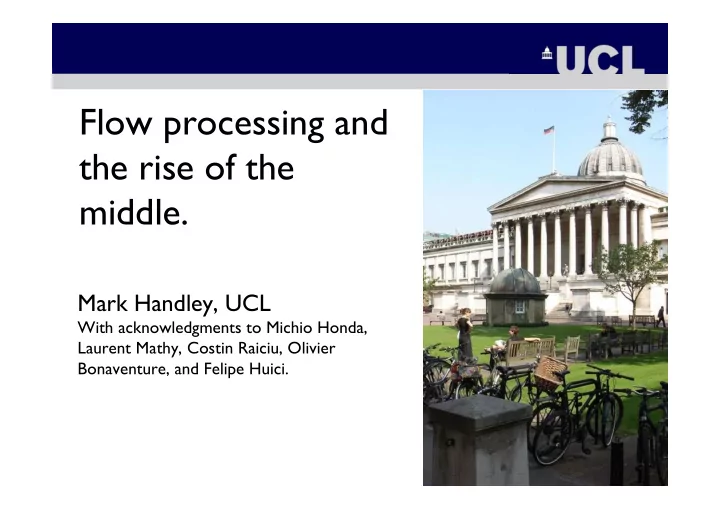

Flow processing and the rise of the middle. Mark Handley, UCL With acknowledgments to Michio Honda, Laurent Mathy, Costin Raiciu, Olivier Bonaventure, and Felipe Huici.
Part 1 Today’s Internet
Protocol Layering • Link layers (eg Ethernet) are local to a particular link • Routers look at IP headers to decide how to route a packet. • TCP provides reliability via retransmission, flow control, etc. • Application using OS’s TCP API to do its job. HTTP HTTP TCP TCP IP IP IP IP Ethernet Ethernet ATM ATM Modem Modem Internet Web Internet Web Router Server Router Client
Protocol Layering • Link layers (eg Ethernet) are local to a particular link • Routers look at IP headers to decide how to route a packet. • TCP provides reliability via retransmission, flow control, etc. • Application using OS’s TCP API to do its job. y l t s o m HTTP HTTP Fiction! TCP TCP IP IP IP IP Ethernet Ethernet ATM ATM Modem Modem Internet Web Internet Web Router Server Router Client
What actually happens to TCP in the wild? We studied 142 access networks in 24 countries. Ran tests to measure what actually happened to TCP. Are new options actually permitted? Does re-segmentation occur in the network? Are sequence numbers modified? Do middleboxes proactively ack?
Middleboxes and new TCP Options in SYN Middleboxes that remove unknown options are not so rare, especially on port 80
What actually happens to TCP in the wild? Rewrote sequence numbers : 10% of paths (18% on port 80) Presumably to improve initial sequence number randomization Resegmented data : 3% of paths (13% on port 80) Proxy Ack : 3% of paths (7% on port 80) Note: all of these paths also removed new options from the SYN Ack data not sent: 26% of paths (33% on port 80) do strange things if you send an ack for data not yet sent.
What actually happens to TCP in the wild? Rewrote sequence numbers : 10% of paths (18% 8% on on port ort 80 80) Presumably to improve initial sequence number randomization Resegmented data : 3% of paths (13% 3% on on port ort 80 80) Proxy Ack : 3% of paths (7% on on port ort 80 80) Note: all of these paths also removed new options from the SYN Ack data not sent: 26% of paths (33% 3% on on port ort 80 80) do strange things if you send an ack for data not yet sent.
Not to mention… NAT Pretty nearly ubiquitous, but comparatively benign DPI-driven rate limiters Lawful intercept equipment Application optimizers Anything at the server end: Our methodology Firewalls will not detect most Reverse proxies of these, but we’re Load balancers pretty sure they’re Traffic scrubbers out there too. Normalizers, etc
IPv6 will save us! No.
Part 2: Tomorrow’s Internet
Option 1: Extrapolate the current Internet Plenty of box vendors will sell you a solution. Whatever you think your problem is. Current apps get optimized and set in silicon. Future apps tunnelled over HTTP (but what do all those port 80 specialized middleboxes do?) Impossible to reason about the concatenation of middleboxes. If you think STUN/TURN/ICE is hard to reason about, you’ve not seen anything yet,
Option 2: Devise a wonderful new Internet architecture that everyone will love and deploy.
Option 3: Reverse engineer a new Internet architecture from the current mess. Observation: The Internet is becoming a concatenation of IP networks interconnected by L4+ functionality.
A segmented Internet IP processing access core datacentre L4+ L4+ processing processing It already looks somewhat like this, but the L4+ processing is more distributed.
A platform for Change Those L4+ platforms need to be more general that today’s middleboxes. More open. More upgradable, as new apps arrive. Aggregate functionality, so it’s managable. Identifiable, so we can reason about them Cheap and scalable.
Flowstream
Flowstream
Flowstream
Flowstream Xen OpenFlow ClickOS
Flowstream OpenFlow FreeBSD + netmap Process (maybe running Click userspace)
Flowstream Xen OpenFlow ClickOS Luigi Rizzo’s netmap: Saturate 10Gb/s with 64 byte packets in userspace FreeBSD + netmap Process (maybe running Click userspace)
Empowering the ends, not just the middle
Types of Processing Monitoring/read-only 1. Drop/filter/rate-limit 2. Redirect (eg tunnel) 3. Tee 4. Rewrite 5.
Authorization On-path providers can instantiate flow-processing functionality. Can’t stop them anyway. Source and destination also share ownership of a flow. Can we allow them to set up flow processing?
Authorization Source or destination-initiated processing: Need some way to pay. Need to avoid hijacking.
Authorization Request from destination is simple(ish) to authenticate. Simple nonce exchange proves requester is downstream. May be sufficient for monitoring, etc. Otherwise need to prove address ownership (eg via RPKI) Request from source is harder. Anyone upstream can NAT traffic to claim ownership. Address proof (even using RPKI) only proves requester is on path upstream.
Becoming on-path Prefer to filter here Can filter here access datacentre DDoS attack
Becoming on-path BGP route for dst access datacentre BGP route for dst DDoS attack
Becoming on-path BGP route for dst access datacentre BGP route for dst Destination ISP has dynamically extended the reach of its network
Change Project http://www.change-project.eu/ Flow processing as a first class primitive Scalable extensible software platform to enable it. Mechanisms to remotely authorize instantiation of processing. Protocols to communicate with flow processing platforms, so we can reason about the network.
Going with the flow… Currently flow processing in middleboxes serves to inhibit new applications. Optimization of the present Inextensible inflexible network security Key question: is it possible to re-claim the middlebox as a force for enabling end-to-end innovation?
Recommend
More recommend